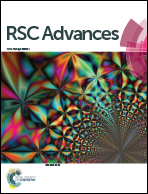Reduced graphene oxide/gold nanoparticle aerogel for catalytic reduction of 4-nitrophenol†
Abstract
Currently, it is of great significance and a challenge to develop facile synthetic routes to obtain a novel plasmonic heterogeneous catalyst with high activity and long lifetime for the reduction of a refractory organic compound like 4-nitrophenol (4-NP). To this end, a three-dimensional (3D) porous framework named reduced graphene oxide/gold nanoparticle aerogel (rGO/Au NPA) was constructed by individual GO sheets and HAuCl4 under the reduction of trisodium citrate dihydrate (Na3Cit) via a one-step hydrothermal method. The abundant Au NPs having a diameter of 7–160 nm can be easily in situ incorporated into graphene sheets to form a 3D hierarchical monolith by the reduction of Na3Cit, which was well-disclosed by field-emission scanning electron microscopy (FESEM) and transmission electron microscopy (TEM). Such 3D rGO/Au NPA with interconnected porous structure displays a good thermal stability and large Brunauer–Emmett–Teller specific surface area of 37.8325 m2 g−1. More importantly, the fabricated rGO/Au NPA can act as a heterogeneous catalyst, exhibiting an outstanding catalytic activity and good reusability towards the reduction of 4-NP due to the synergetic effect between Au NPs and graphene sheets. Additionally, the mechanism of enhanced catalytic efficiency for the 3D rGO/Au NPA catalyst has also been proposed.


 Please wait while we load your content...
Please wait while we load your content...